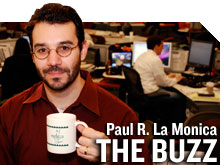
Even though there are many reasons to worry about stocks and the economy, bearish investors are still in hibernation. Short interest is near pre-Great Recession levels.
NEW YORK (CNNMoney) -- Still no debt ceiling agreement. The job market stinks. Europe is a mess. You would think that this would be the time when the bears would be loudly shaking their paws on Wall Street.
Sure, stocks were falling Monday after a tough couple of days last week. But by at least one market measure, it appears that investors are nearly as bullish as where they were before the Great Recession began. Say wha?

The level of short interest, or number of shares being held by investors who borrow stocks and quickly sell them with the hopes of buying them back later at a lower price, is surprisingly low.
According to research from Brockhouse Cooper, a Montreal-based brokerage firm, short interest on the New York Stock Exchange is just 3.4% of overall shares. That's about where this level was in December 2007. And it's off sharply from the peak of 4.9% during the height of the 2008-2009 bear market panic.
Short sellers profited handsomely during the bank stock crash in 2008. So why are these bearish investors, commonly referred to as shorts for, uh, short, now in hibernation?
The simplest reason is that anyone who has been short stocks since the market bottomed in March 2009 has probably lost a ton of money and can't afford to go aggressively short now even if they wanted.
"The short community has been bludgeoned for the past two years. Nothing has worked," said William Fleckenstein, president of Fleckenstein Capital, a hedge fund in Seattle. "The market has forced short sellers to cut back and they have less capital. It's a function of the relentless rise of stocks."
Fleckenstein said he actually shut down his short fund in March 2009 and has been mostly buying gold and other commodities since then.
Still, other market experts said investors should not mistake the lower level of short interest for an absence of fear.
Ryan Detrick, senior technical strategist at Schaeffer's Investment Research in Cincinnati, pointed out that there are other ways for investors to hedge portfolios or make bearish bets on stocks.
Detrick said that one such strategy is to buy put options, instruments that give you the right to sell a security at a certain price at a specified date. And interest in puts has exploded as of late.
According to Detrick, put volume on two prominent exchange-traded funds is up sharply from a year ago. Through the end of the second quarter, average daily put volume for the SPDR S&P 500 ETF (SPY) was up 38% while put volume for the iShares Russell 200 Index Fund (IWM) (a key gauge of small company stocks) was up 19%.
It's important to remember that the Great Recession and 2008-2009 bear market may have frightened away a lot of potential buyers (and sellers) of stocks for good. Trading volume has fallen and a large chunk of consumers claim they may never invest in stocks again -- not even for retirement accounts.
With that in mind, Detrick said it's not a shock that short interest is low. The more experienced traders that are still in business may be using options instead.
"Just because short interest is low doesn't mean people are not scared and trying to protect themselves," he said. "But a lot of people have left the market and those that are still trading are more sophisticated."
And even though the percentage of shares being held short is still relatively low, analysts at Brockhouse Cooper pointed out that the absolute number of shares being shorted is up slightly.
In particular, it looks like short sellers are targeting retailers and other consumer discretionary stocks, probably due to the belief that consumers will have to pull back if the economy slows further. Along those lines, J.C. Penney (JCP, Fortune 500) and Best Buy (BBY, Fortune 500) are two retail stocks where investors have relatively high short positions.
But the pullback in overall short selling could be a troubling trend. It seems counterintuitive but when more people are shorting stocks, it actually creates eventual demand for those shares down the road. The shorts have to buy back the stock eventually to cover their positions.
So the fact that shorts are slumbering now may mean they are just biding their time and waiting for the right opportunity to get back into the market. What's that they say about not bothering a sleeping bear? Roar!
The opinions expressed in this commentary are solely those of Paul R. La Monica. Other than Time Warner, the parent of CNNMoney, and Abbott Laboratories, La Monica does not own positions in any individual stocks. ![]()
| Index | Last | Change | % Change |
|---|---|---|---|
| Dow | 32,627.97 | -234.33 | -0.71% |
| Nasdaq | 13,215.24 | 99.07 | 0.76% |
| S&P 500 | 3,913.10 | -2.36 | -0.06% |
| Treasuries | 1.73 | 0.00 | 0.12% |
| Company | Price | Change | % Change |
|---|---|---|---|
| Ford Motor Co | 8.29 | 0.05 | 0.61% |
| Advanced Micro Devic... | 54.59 | 0.70 | 1.30% |
| Cisco Systems Inc | 47.49 | -2.44 | -4.89% |
| General Electric Co | 13.00 | -0.16 | -1.22% |
| Kraft Heinz Co | 27.84 | -2.20 | -7.32% |
| Overnight Avg Rate | Latest | Change | Last Week |
|---|---|---|---|
| 30 yr fixed | 3.80% | 3.88% | |
| 15 yr fixed | 3.20% | 3.23% | |
| 5/1 ARM | 3.84% | 3.88% | |
| 30 yr refi | 3.82% | 3.93% | |
| 15 yr refi | 3.20% | 3.23% |
Today's featured rates: